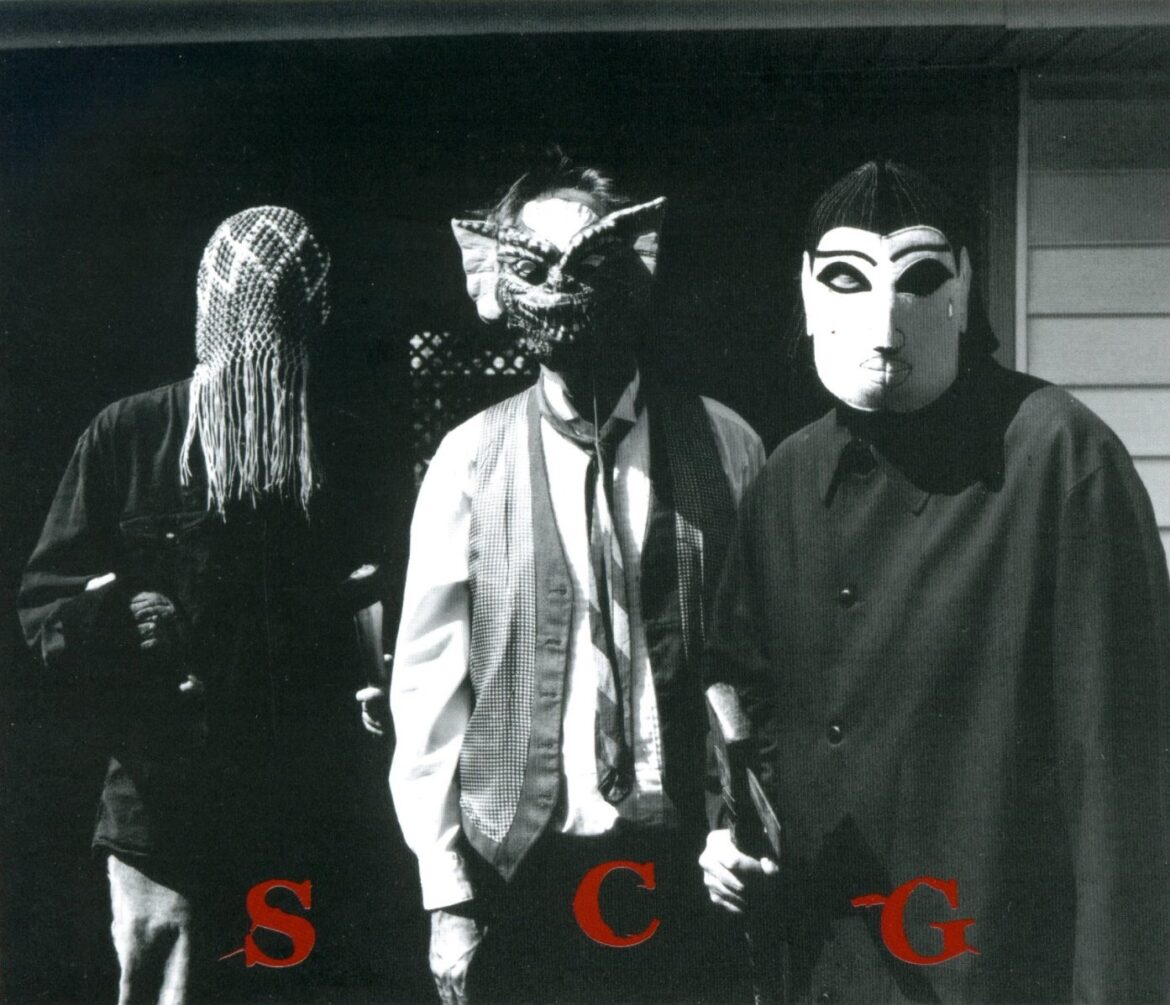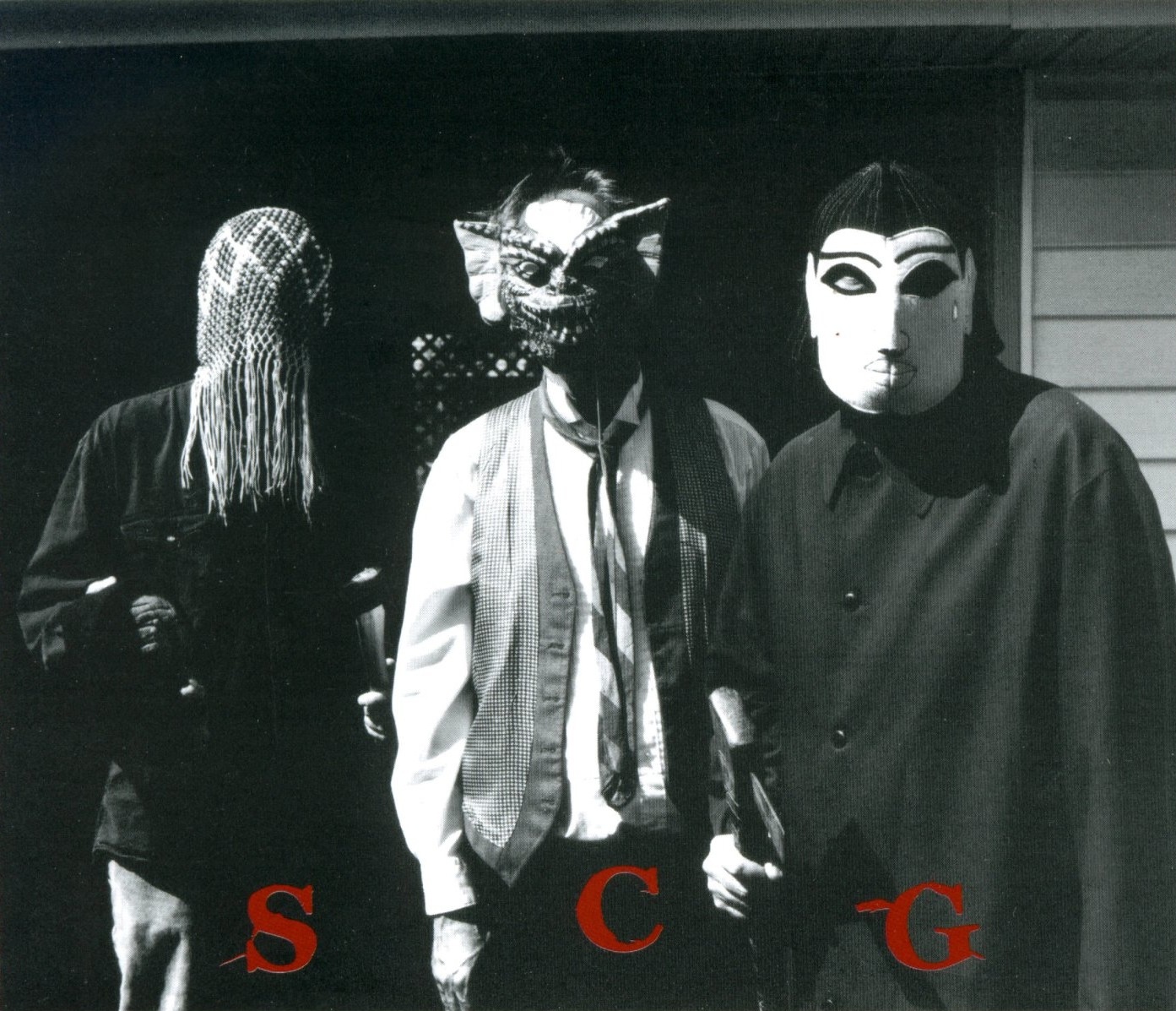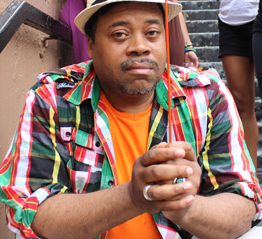
Profile of the Sun City Girls
Alan and Rick Bishop are two halfbreed desert rats on the cusp of middle age who live in Seattle and play, when they do, in a trio called Sun City Girls. Rick’s on guitar and Alan plays bass and sings, but the brothers play with lots of other things as well: double-reed pipes, gamelon, puppets, language, demons, audience expectations, states of consciousness. The third Girl is named Charlie Gocher and he’s a scraggy Californian transplant the Bishop boys first met in the open-mic scene in Phoenix over twenty years ago. Gocher plays drums — open, slippery, consternating drums — and he writes and occasionally lets loose some mighty ornery post-Beat rants.
The brothers are addicted to third world travel, and have been so since they first hit the Moroccan hinterlands in 1984. Gocher has joined a Bishop expedition only once, during a 1989 trip through Indonesia. One night in Yogyakarta, a seaside city on the coast of Java, the trio stumbled into an itinerant Kuda Kepang group, a family troupe that entertained the crowds with a ferocious, gamelon-fueled mixture of magic tricks, hobby-horse theater, and glass-eating, fire-breathing performance trance. Whenever tourists stopped, the leader cracked a bullwhip next to their heads and scared them off.
The Girls, characteristically, held their ground. Years before, when they first hit the stage with their peculiar mix of sardonic rock, trickster improv, and hippie mysteriosa, they could only get gigs at punk shows, and the crowds responded to their baffling sets and bizarre costumes with anger and violence. The band came to aggressively taunt these people, dishing out verbal abuse, sarcastic musical moves, and the occasional cup of urine. Guys like that can certainly deal with a stingless lash from a Javanese heavy. They could even see where the guy was coming from.
So every night the three young men would wait for what they called “the call of the wild:” the distant madcap clang-clang-clang-clang that would lead them through the crowded city to the Kuda Kepang crew. After two weeks of this, they had almost become part of the family, with Charlie banging out percussion as Alan fed lightbulbs to the kids, their mouths a repulsive mass of lacerations and kerosene burns. You could say a sort of transmission occurred. Alan describes it simply as “the best show ever.”
A month and half later, the Girls were on a boat, heading through the Strait of Malacca on their way to the Sumatran city of Medan. With nothing better to do, the trio asked the boat’s lounge act to hand over their electric instruments for a set. The band ripped through what one might could call a “typical” Sun City Girls set: “House of the Rising Sun,” “Esta Susan En Casa?” from Horse Cock Phepner, and a sun-baked skronk-jam peppered with abrupt stops and starts. The Indonesian audience clapped at the beginning of every song, and then clapped again at the end. Like nearly all Girls performances, this one was recorded, and Rick reports that at one point on the tape you can hear a patron lean over to his companion and proclaim: “Ah, this is American jazz!”
Purists might have trouble with this description, of course, although SCG are more than capable of pounding out Duke Ellington and Paul Bley tunes. But if jazz means a deep commitment to improvisation, and if improvisation means having the guts to force the hand of chance, then Sun City Girls are most certainly jazz.
They are most certainly not purists. Sun City Girls traffic with bizarre miscegenations, self-indulgent trash, and hardcore mystic exotica. Their sometimes garish album covers attack the eye with devils, yonis, sacred transvestites, and nubile native jailbait. Lyrics, song and album titles — “Naga Smoke Signals,” “The Genghis Necro-Nama-Khan,” 330,003 Crossdressers from Beyond the Rig Veda — can sound like the spontaneous verse of young poetes maudites tanked up on National Geographic cheesecake and A Pictorial History of Magic and the Supernatural. This lurid romance with the Other fuels some of their most incandescent sounds as well, a music of transport that explores Middle Eastern, Southeast Asian, and South American atmospheres with a passion composed equally of informed pleasure and the heedless appropriation of the strange. Looking high and low, far and wide, the Sun City Girls have sought the wellsprings of the weird, of what H.P. Lovecraft called outsideness, and when they have found them, they have taken what they wanted. And on that boat in Indonesia, they got to give some of it back.
***
Sun City Girls released the first of their countless recordings twenty years ago, and in that time they have become probably the most prodigious, uncompromising and caustically esoteric band in the American post-punk underground. They are musical chameleons, and have performed tantric space jams, out jazz, riff rock, Sumatran pop covers, spaghetti-western soundtracks, and haunted folk songs worthy of Harry Smith. But they started out simply jamming, back in that trailer park in Tempe Arizona, their three instruments creating a whirlwind of noise that Alan compares to a nuclear explosion.
“It was like we discovered this switch,” he says. “Without really playing together very long we were listening and improvising and hitting synchronicities that we didn’t even think were possible. Within a twenty minute piece, we were stopping on dimes, not even looking at each other, fifteen times. Rick and I would hit eight or nine straight notes, the exact same notes, with Charlie accenting them. How the fuck is that done?”
According to Forced Exposure‘s Byron Coley, Sun City Girls were “the first truly crazy band to emerge from the shards of hardcore. At first they seemed almost like a goofus prank being played by post-core stoners, but by the time that Torch of the Mystics was released, they were absolutely amazing and obviously pure of heart.” When Majora released Torch in 1990, Colely helped spread the news, and the album’s astral caberet of voodoo folk jams and dark ethno-psychedelic rites remains the band’s most celebrated release. According to Colely, Sun City Girls laid the foundation for today’s new American sub-underground. “Without these french-fried, grass-skirted motherfuckers it would all sound like Merzbow.”
Sun City Girls also became some of the most original performers in American rock. Simultaneously wanting to shock, amaze, and irritate, the Girls used the stage as a platform for snotty tricks and bravura experiments that tested both themselves and their audiences. One night they played nothing but an extended version of a single soul tune; another night they executed a perfect cover of Jodorowski’s El Topo soundtrack; and sometimes they just ditched their instruments altogether. Once, opening for fellow travellers Thinking Fellers Union 242 at San Francisco’s American Music Hall, the trio donned cheap Radio Shack wireless mics, plopped down on the stage, and improv’d a group of hobos waiting for a train while a prerecorded 50-minute tape of crickets ground toward the inevitable whistle moan. Their longtime sound engineer Scott Colburn came on and danced a tramp jig, while Grocher sprayed peach air freshener in the air and threw marshmallows around, ruining the carpet.
“That’s classic Sun City Girls,” says Colburn. “You get what you get.”
These days, a Sun City Girls gig is a rare affair that draws the converted. Last November, I was lucky enough to catch an unadvertised all-acoustic show at the Rendezvous, a jewel box theater in Seattle’s Belltown that looks like a padded cell for mad Napoleons. Their first gig in over a year, the Rendezvous show celebrated their 21st anniversay as a trio. It also served as a warm-up for an upcoming performance at the Java Jive, a tiki dive in Tacoma, Washington that’s shaped like a coffee cup and known for whore karaoke and the occasional strip-show with live monkeys.
As the bird-like Grocher slipped behind his modest kit, a bearded and shade-wearing Rick began a snarly song about “the audience who’s come here to dream.” Alan passed through the crowd of hirsute and scruffy musos like an androgynous Uncle Fester, pouring a bottle of Old Crow straight into people’s mouths — a ritual I later learn he lifted from Burmese spirit mediums. Between covers of “Midnight at the Oasis” and “Heart Full of Soul,” the trio played some of the misanthropic folk tunes Alan has recorded for his Alvarius B solo project, and which make him as proud as anything he’s done. Perhaps for my benefit, they play a game-show spin-off of the Wire‘s “Invisible Jukebox,” with Rick plunking out songs on a ukelele-toned kid’s guitar, as Alan handed out mint-condition LPs 23 Skiddoo, Duke Ellington, The 50 Guitars of Tommy Garrett — to whoever could name the tune.
Inevitably, perhaps, the mysterious Sun City Girls “X Factor” struck. During one of Grocher’s cubist drum rambles, a thick and tipsy nouveau jock walked into the theater, clad in a sweatshirt, Yankees cap, and nu-metal facial scruff. Booker, as we subsequently learned this apparation was called, had no idea what was going on, but he nonethless clambored onstage and demanded that Grocher kick up some funkier beats. In response, the drummer brought his brushes down to a whisper. Booker kept at it and Charlie grew cranky: “I do what I want to do. Not what I’m told.” Charlie then stood up and told Booker to take over on drums, but the fellow turned to the audience instead and started beat-boxing. Charlie and some audience members led the suburban B-boy offstage as Alan started pulling spastic jujitsu moves around this ghost of their punk-rock past. As Alan said later, “We must have conjured him up.”
***
The Sun City Girls’ inner sanctum takes up one half of a former theater on a low-rent commercial strip in Seattle’s Ballard district. Their entrance room is filled with slacker shrines and towering shelves of LPs carefully filed away in crisp plastic sleeves. Alan’s office is off to the side, and further on is the huge blue room that serves as the main rehearsal/hangout space. Here American Spirits are endlessly smoked. From the walls hang a collection of curious stringed instruments: banjos, mandolins, a Burmese harp, a Russian balalaika, a thrift store score called an Orie Tone. A Kali poster is slapped onto the side of an upright piano that belongs in a saloon, with Liszt’s score for “Dance of the Demon” displayed on a nearby music stand. On the floor lies the crumbling gamelon orchestra that a Javanese puppet troop dragged around Indonesia for 27 years before Alan got it at a Folklife Festival auction. A red devil mask leers from above.
I am barely over the threshold of this strange place when I catch the title of a burned CD-R sitting on Alan’s desk: Broken Hearted Dragonflies. The man immediately starts telling me about these fat Burmese insects whose chests routinely explode. Alan’s wife, who is Burmese and “from another planet,” says they are called broken-hearted dragonflies, and Alan has written the phrase onto a friend’s recording of Thai insect squalls whose intense electronic tones, I soon learn, vibrate with an almost nauseating menace. “Maybe I’ll put it out,” Alan says, as he finally turns the volume down. “But I probably couldn’t move more than 500 copies.”
Alan wears a backwards baseball cap tugged tightly over a close-cropped skull that accentuates his thin elvish ears. He is hefty and slightly wall-eyed, and has the somewhat disconcerting habit of not always looking at you as he speaks. He’s not the cagey hipster I expected. With his amusing, smart-ass patter, he comes off like a friendly hustler who wants to sell you an 18th century kilim or tell you where the best ping pong shows in Bangkok are to be found. I’m not surprised to learn that for twelve years, Alan worked for one of the largest ticket brokers in the world, a business he compares to the Sopranos without the violence.
Alan’s restless energy and immense drive lies behind the manic productivity of the Sun City Girls, who have left a huge and serpentine trail of recordings in their wake. Scott Colburn’s online discography lists around 45 full-length releases, and Alan estimates that only a couple of hundred people have heard more than half their hydra-headed catalog. And they like it this way. In the early 90s, when stalwart 80s outsiders like Sonic Youth or the Butthole Surfers were cashing in on the capital-infused expansion of indie rock, the Girls quit Majora, founded their own Abduction label, and continued releasing 1000-copy runs of Lps and Cds that went out of print more or less quickly and more or less stayed that way. Believe me, you don’t need to collect ’em all. And you couldn’t do it if you tried.
“We have the luxury of a huge backlog of recordings,” explains Alan, who is an obsessive archivist. “Why press 5000 copies of one record and sit on 3500 when you can run five different projects that sell out? It’s just basic business. Don’t put your money into boxes in the closet.” This strategy has certainly led to lots of self-indulgent crap, but the Girls’ hyperactive catalog is of a piece with the band’s overarching improvisatory ethos. “We make hard decisions and we make ’em quickly and we move on,” says Alan. “The downside of that approach is that there is too much for people to digest. The upside is that it’s fearless. We don’t sit around and analyze the fact that we’re releasing this or that. So we leave a few diamonds by the roadside and we leave a few heaps of teradactyl shit as well. Its like a big wagon with sparklers and fireworks going off with a trail of dust behind it.”
Though the pace is slowing, the wagon continues to roll. Alan has released an Alvarious B disc with Dylan Nyoukis entitled Sugar: the Other White Meat, while Rick has followed up his great Salvador Kali solo album with a mesmerizing slab of oud-ish steelstring on the Locust comp Wooden Guitars. Abduction continues to crank out the Carnival Resurrection Series, an alternately marvelous and ridiculous set of recordings culled from hundreds of hours of taped rehearsals from the 90s. Majora has re-released some of the Girls’ classic albums from the early 90s, Eclipse has started packaging edited versions of the 1980s “cloaven cassette” series into beautiful double-vinyl gatefolds, and Locust has put out gorgeous triple-fold albums of Dante’s Disneyland Inferno and 303,000,000 Crossdressers, an album of lost traveler’s dreams that rivals Torch.
Alan’s gig as a legal ticket scalper helped the Girls maintain the curiously profane purity of their sub-commercial style. “It was never our intention to ever make much money as a band, even from day one,” he says. “We made a pact: If we ever wind up on MTV we gotta shoot ourselves.” Last summer, though, Alan quit his dayjob to devote himself fulltime to SCG and related projects. “I work every day,” he says. “I’m relentless. I want to do as much as I can in 5 or 10 years before I get fed up with the bullshit that this society puts out and relocate to a place that’s less predictable and ridiculous.”
There’s plenty on his plate the day I visit. Hisham Mayet, a friend and cohort who goes by the handle Frank Sumatra, has just gotten back from Libya with 12 hours of footage taken at the Ghadames music festival. Mayet also snagged a box of North African 45s from his family’s basement in Tripoli, and these discs need to be combed through, the nuggets burned onto CD-R and added to the archive, where they may become fodder for a future Girls tune or a release on their new label, Sublime Frequencies. Alan’s working on the first official Sun City Girls website, which will release, among other goodies, DVD/video collages culled from their vast stores of taped shows and skits. Abduction has just released a record by Neung Phank, a Thai-lounge-core side project of the Bay Area’s Monopause, and is preparing to put out Carnival Folklore Resurrection Radio, a double CD featuring an awesome tape-collage radio show broadcast on WFMU in 2002.
Alan is particularly psyched about Sublime Frequencies, which will be devoted to CDs and DVDs of unusual international music and culture. The first batch of releases includes three CDs of music captured during the band’s 1989 visit to Indonesia: Radio Java is a surreal fever dream of spliced commercial broadcasts; Night Recordings from Bali features field recordings of raw and giddy village gamelon; and Folk and Pop Sounds of Sumatra Vol 1 culls the choicest cuts from their collection of sometimes nameless streetside cassettes, and which includes at least one tune that the Girls have covered, with more passion, as a single. The jewel in the batch is Nat Pwe: Burma’s Festival of Spirit Soul, an hour and half DVD devoted to Burma’s nats: godlike spirits of the dead who take possession of transvestite mediums, consume liquor and cigarettes, demand fistfulls of cash, and grant boons. The Nat Pwe is a yearly festival of this gamelon voodoo, and the DVD, which Alan and Rick shot last summer on their high-end Canon GL-Z, captures the wild scene and its mad-cap soundtrack with a fascinated gaze.
The Bishop brothers hope that Sublime Frequencies will fill a gap in what Alan calls “international recordings,” presenting unusual documents with a passionate informality rather that the clinical dissections of Smithsonian/ Folkways or the high-tech fetish of lots of world fusions. “It doesn’t have to be funded,” says Alan. “You don’t have to go to school to learn how to record or to learn how to interpret a foreign culture or bring it back and spin it for someone. You don’t need to have 500 microphones, you don’t need to gather up these people for recording sessions and pay them 1000 dollars a piece. As far as I’m concerned, its open season, and you record what you want to record.”
“It’s disappearing too,” adds Rick. “It’s good to get it while you can.”
***
By the standards of multicultural propriety that shape the discourse of “world music,” the Sun City Girls are, well, rather crude. Folk and Pop Sounds of Sumatra Vol 1, for example, offers only vague credits and no compensation to the original artists. Alan insists he tried to track down the publishers, but to no avail, and he adds there is no money in it anyway. “When it starts selling like fucking Outkast I’ll fly to Medan and start handing out Benjamins to anyone who looks like these guys.”
More disturbing is the absence of the prose and packaging that usually mediate international recordings. The Nat Pwe DVD comes with a short bibliography and some brief explanation, but the film itself offers no informative voice-over. Combined with some very long takes, the lack of an anthropological filter is uncomfortable, invoking the raw bafflement and delirious boredom that travellers taste when they find themselves confronting something beyond their ken. This confrontation is key to the Sun City Girls. Theirs is an ethnographic surrealism that stalks the marvelous, using the encounter with confounding and unusual human practices as a neuron-pumping portal into the outside. Their surrealism can be coarse, even purient, and calls to mind the Mondo Cane world of international shockumentaries that were popular in the 1960s. Interspersed with the Nat footage, for example, Rick has included phantasmagoric clips of snake handlers, drunks, toothless kids, merry-go-round beasts, and lots of disarmingly cute girls. Occasionally the camera’s gaze will rest on faces whose return stares suggest a smoldering hostility, a resentful recognition of recording’s fundamental theft.
However “problematic,” the Sun City Girls’ relationship to third world music culture is an extension their own dark romanticism of travel. “We’re always looking for the end of the line,” Alan says. Most tourists seek otherness, of course, but in the words of Peter Lamborn Wilson, an underground historian of heresy and a great traveller, tourism deconstructs difference while true travelers experience it. Tourists (and many consumers of “world music”) buy prefab images of the exotic, but travellers fall in love — or become entranced. Such enchantments run the rick of Orientalism, of course, but there are many babies in that bathwater. How many of us become armchair Orientalists when the headphones are on? Tourist exoticism prolongs imperialist colonialism, of course, but Wilson points out that deep travel, in the soul and in space, extends the “heretical margin” — a liminal zone that exists, not within homogenous traditions, but between them as they dream and penetrate one another.
During one of our chats, Alan invited me to take a turn at the gamelon. I crouched down, and, fumbling about, asked him how to play it. “My philosophy is that there is no set way to play any instruments,” he told me. “Obviously there’s a sense of respect for how to play something like the gamelon. But to give in to that respect you don’t do right by tradition. Tradition is not about slavish imitation. The last thing I want to see is a bunch of fucking white guys playing Javanese gamelon proper. It’s disrespectful.”
The term struck me as odd. Many people, after all, would consider the Girls’ psychotronic appropriation of native instruments and nonwestern languages distinctly disrespectful. So I asked him what he meant.
“They are being disrespectful because they are not evolving the situation. They are not rolling the dice. They are copying, just following somebody else’s rules. That’s not what you find in these situations.” Instead, Sun City Girls risk insensitivity, political incorrectness, and crappy music to evolve the situation, and their punk disdain for multicultural pieties paradoxically allows them to extend the creative logic of folk appropriation. That’s why you can’t always tell the difference between the “ethnic” tunes they make up and the “ethnic” tunes they cover, and why Alan babbles in languages he does not understand, and why their version of the insidious “Lambada” meme of the late 1980s is without a doubt the most moving you will ever hear. Call it underground world music, or underworld music, a place of creative misunderstandings and mutual fascination.
And it is mutual. Before heading to Tayngbyon to film the Nat Pwe last summer, Rick and Alan bought two 8 dollar guitars and entertained Burmese folks along the way. They improv’d plenty, but after being hounded for weeks, they finally broke down and learned to perform their most requested tune: “Hotel California.” They knew that, when it comes to the desires that inflame human music, you just can’t kill the beast.
***
This matter of Orientalist appropriation is further complicated by the fact that the Bishop boys have the Orient within, coded into their DNA and the tenderest layers of their memory banks. Their grandfather was a Christian Druze named Jamil Salman, and he left Lebanon as a kid to tap rubber in the Brazillian Amazon. After saving enough money, he returned to the Levant and brought his family to the States, where the boys’ mother was born. Alan and Rick grew up in Michigan, which has one of the largest concentration of Arabs in America, and Lebanese friends and family would often gather at Salman’s house on the weekends to party. The boys remember slick small-time businessmen in funny suits hanging out in their grandfather’s tapestry-lined basement, sucking on hookahs, consuming sweetmeats and coffee, and playing music into the night, pop songs and long instrumental jams. Salman was a master oud player, and also took turns on shroud fiddle, doumbek, and various double-reeded horns.
When Rick started playing guitar, he acted as any red-blooded Midwestern boy should and worshipped Jimmy Page, Richie Blackmore, and the almighty Nuge. But at a certain point he stopped aping and started just fucking around. An early cassette of solo acoustic stuff drips with metal, but there’s no order or obvious structure to the riffs, and weird Middle Eastern melodies keep wafting through. “That’s just from growing up with that stuff,” he says. But even though these sounds bubbled up from his ethnic matrix, Rick still appreciates them as a mode of imaginal transport rather than personal identity. “Middle Eastern music is not caged in by having to have the guitar here, the drums there, the voice over there. Regardless of what notes you’re playing, it’s the overall feel of the music, the atmosphere, that’s important. It puts you in, for lack of a better term, an exotic place.”
For the Bishop brothers, the exotic is a kind of birthright, a point at once of origin and the obliteration of the ordinary self. Their grandfather’s home dripped with mystery as well as music, an old world atmosphere of creepy wonder that helped spark the brothers’ later fascination with the nether regions of spirit and the sacred forces that surround sex, death, and the utterly deranged. Salman was also a Freemason, and encouraged his grandsons to join a junior Mason’s club called the Order of De Molay. The elders would bring the boys into the temple, sit them down between pillars on a black-and-white checkerboard floor and whisper things in their ears. “We didn’t know what was going on,” says Rick. “It wasn’t until later that we found out who Jaques De Molay was, that he was head of the Knights Templar and burned at the stake for heresy. We went: Yah! We have a history again!”
For Rick, that toy initiation blossommed into a lifelong love-affair with the occult. The Orientalist vibe of Masonry led him into Egyptology, and from there he moved into Crowley, sexual ritual, Haitian voodoo, tantra. “I don’t claim any powers,” he says with a grin. “I just keep reading, keep taking it in. I figure I’ll remember it when I need it.” Along the way, he also started collecting esoterica, and for years he has made a most modest income buying and selling items like Jacques Collin de Plancy’s Demonographia, Michael Allen’s The Cult of Kumari: Virgin Worship in Nepal, and the 1913 edition of Budge’s Book of the Dead.
Rick is very much a younger brother. Though friendly, he is more reserved and pensive than Alan, and dresses in a surprisingly slubbish manner that the wag behind the great Blastitude webzine compared to a high school basketball coach. What’s going on inside is clearly what counts. There is a curious humility about him, as if he lives in the awareness that, as he said at one point, “if certain things didn’t happen in the past, I could be working at Walmart now and going to church on Sundays.”
Instead, he lives in a freak scholar bachelor pad above the band’s rehearsal space. Django Cds are piled next to a collection of goofy ithyphallic monsters from Bali. A futon lies near a shrine filled with personal power trinkets and bookshelves packed with an enviable collection of esoterica. The front wall of his office is lined with tactical pilot maps of Assam, the northeastern Indian province that is his next travel destination. He wants to visit the Kamakhya temple in Guwahati, a Shakti hotspot where the yoni of Shiva’s dismembered first wife was said to have fallen. He hears that tribal witches gather there, near a cunt-shaped cave that regularly “bleeds” rust-colored water.
Rick, you see, is a devotee of Kali, the black tantric goddess often pictured with a protruding tongue, a necklace of human heads, and the lingum of Shiva erect beneath her femme fatale thighs. Images and statues of Kali saturate his space. “She kinda lives here,” he says, a little sheepishly. “The whole tantric thing interests me, not just the sexual symbolism but the graveyard symbolism. There’s something about the gore of it all. I’m not into going out and hacking up people, but there’s something about that imagery that’s really powerful.”
Rick got his best hit of that gore when he visited a Kali temple outside of Kathmandu. The priests chopped the heads off small goats, hugged the bodies like submachine guns, and directed the spurting blood onto the statues of the goddess. Soon the floor was covered with blood. “It smelled kinda good actually. In the corners where the blood would roll off there were all these marigolds that were blocking the drain and these dogs came up and licked up all the blood. These beautiful little five or six year old girls in solid white just walked in the blood. Then they hauled the rest of the goat off to the family and they ate it. It’s a whole family event.”
Bishop reminds me that, to the people who know her, “our lady of the cremation ground” also serves as a compassionate mother goddess. But the eldritch dark still sets the dominant tone of Rick’s spiritual universe. “I’m fascinated with the demonic,” he says. “Demons get a bad rap, but they’re real. That’s the key. I believe that spirits and demons are real, in whatever abstract or physical sense you want to put it in. Nobody gets that much publicity if they’re not real. Demons are everywhere. I think I’ve been a demon before. I bet you have too. I bet we’re all demons.”
***
Rick Bishop may have made made his pacts with the beyond, but the question before us now is how such activity informs the music of the Sun City Girls. As Rick talked about his devotion to Kali, I asked him about the ritual practices he undertook — always a tricky issue for Westerners.
“I can’t approach it like a Hindu because I haven’t done the studies a Hindu would do,” he said. “But it doesn’t matter. There’s still a connection. So if I want to worship Kali — and it would be bad for me to say that I never do – I’m gonna do it when I know I have to do it. And I’m gonna improvise. It could be silent inside, it could be through her images, it could be with incense or whatever. There’s no order to it. I don’t do it three times a day because, well, I don’t have to. I don’t have to do it at all. But sometimes I do.
“It’s kind of the same way with our music. Sure we don’t always improvise, but if you’re gonna play music and improvise, just like you might perform a ritual, you’re gonna try to approach it in a certain way. It’s always good to not know. If you approach the thing in an established way, you’re assuming that you have to do it that way because that’s what’s required. But if you just play off the energy at the time…”
“It’s strange,” says Alan. “When the three of us are on stage and we’re in it and we’re on it and the electricity is moving, we get this thing going to where it’s an unexplainable phenomenon of energy. It’s like traveling overseas: how far you wanna go? We trust it, we live for it at times. And it’s an addictive thing.” The longer they have played together, the more this “invocational phenomenon” seems to occur. “I sometimes don’t know where some of this stuff comes from. Are we just receptors channeling personalities? Are some of the more flamboyent characters from the last five thousand years just pirating right through?”
Anyone familiar with Alan’s singing would have to offer a qualified yes, as his vocal chords are regularly hijacked by a range of strange and androgynous entities: a moonshine-swilling hick, a sarcastic guttersnipe, an Indonesian banshee, and a hilarious two-bit wise guy named Uncle Jim. “Often I fall into characters that I’ve already evolved and its comfortable,” says Alan. “But sometimes if the path is open I can invoke some character I’ve never invoked before.” In the beginning of the aptly-named 11-minute title track of Cameo Demons and their Manifestations, for example, Alan randomly coughs. Then he starts dredging phlegm from the back of his throat, a nauseating deep hiss that mutates into a Gollum-like wraith whose infernal whispering channels the pitch black below as eerie close-miced shaman rattles pan back and forth through the mix.
Then there’s the matter of the garbled or fake tongues that Alan spews during some of the band’s “international” tunes. Alan knows bits of Indonesian, Spanish, and Burmese, but he’s not particularly facile with languages and some of his singing is outright glossolalia. “Sometimes I’m singing exact words from a language and sometimes I’m not singing words from any language,” he says. “And sometimes I’m singing my own language of before birth and after death.” Alan guesses this peculiar skill started when he was a kid, making fun of Chinese or the Arabic he heard at home, but now it has blossomed into an expressive art beyond linguistics — a vocalization of the unsayable. That’s also why Alan prefers to listen to music sung in languages he doesn’t understand. “I like things that are undefined. It’s the same attraction to travel, to going out as far as you can go. Whether its in your face or very subtle, I’m looking for the undefined.”
I wonder how desperate this search may become. The world today is experiencing a claustrophobic saturation of mediation and control, as the totality of human existence is recoded into a grid of data that saps the romantic imagination and blocks the ancient avenues to the beyond with cheesy simulacra and manufactured fear. And so I ask them whether their search for the undefined, for the space before birth and after death, is harder to achieve these days.
“Maybe,” says Alan. “Everything seems to be closing in. There’s a spin out there that people aren’t as free, that there’s too many rules, too many obstacles to be able to express ourselves. It seems harder to get to the folkloric knowledge that could be far superior to what this reality we supposedly live in has to offer. I don’t think we’re really that restricted though. I think it’s all still there and can be tapped into. But perhaps too many people have the power now to convince us that it’s not possible.”
In such a world, it’s good to keep the doors of perception as wide open as possible, if only for the otherworldly perspective it provides. “When I look at Ashcroft and company, I’m looking down at them,” says Rick. “I refuse to give them power. Sure they could come at me anytime. But until they come knocking at the door, I’m going to put myself above them. When it’s all said and done and we move on, it’s not gonna mean anything. I’m only planning for the next whatever-it-is, the next life, the next big flash. The big bright light, whenever it comes.”




